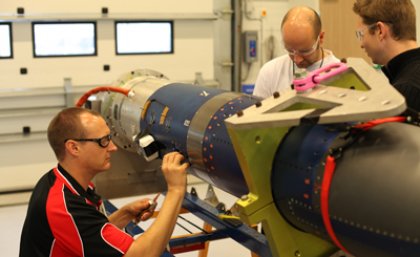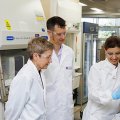
The six-day window to launch Australia’s SCRAMSPACE hypersonic scramjet begins on Sunday, meaning the research flight could launch any day in the week following.
The data-collecting research project led by The University of Queensland is scheduled to launch between September 15 and 21, subject to weather and testing.
SCRAMSPACE Director and Chair for Hypersonics at UQ Professor Russell Boyce said the team was ready and eager to launch the $14 million research project, which is capable of reaching speeds of 8600km/h.
“The team has been preparing since we arrived on September 9 and we have successfully tested the various systems and subsystems of the payload throughout the week,” Professor Boyce said.
“The equipment is looking good. The payload is looking good. The weather is looking good. We’re ready for launch.
“The team can’t wait to get started,” he said.
SCRAMSPACE is a three-year, $14 million project with the potential to deliver solutions for making sending satellites into space cheaper and more efficient.
On launch, the spacecraft will reach an altitude of 320 kilometres, powered by a two-stage rocket. After leaving the atmosphere, the scramjet vehicle will separate from the rocket and, using small thrusters, orient itself for the re-entry for what Professor Boyce describes as a “hypersonic swan dive”.
During the return flight, gravity will accelerate the vehicle to Mach 8 – about 8600km/h. This is when the team will collect the most valuable data, before the scramjet self-destructs over the sea as planned.
“The test period itself will last for just three seconds before the scramjet completely combusts, but the amount of data we can collect in those seconds is enormous,” Professor Boyce said.
SCRAMSPACE Technical Director Dr Sandy Tirtey is the team member responsible for hitting the launch button, following a 3.5-hour countdown and a 40-page launch procedure.
“The pressure is on, but the team is confident the SCRAMSPACE is technically and mechanically sound, and ready to fly,” Dr Tirtey said.
The scramjet will be launched at Andøya Rocket Range, 300km north of the Arctic Circle.
The international research team of 13 partners and sponsors (below) involved is also primed for take-off.
“We are extremely excited about the potential impact of the data that could come out of this test flight,” Professor Boyce said.
The data will give insights into hypersonic physics, hypersonic combustion, performance of materials and components, and how these vehicles will fly in future.
Professor Boyce said that scramjets have the potential to solve international aerospace challenges.
“This one will help maintain Australia’s position as a world leader in scramjet research,” he said.
“As part of the Australian Space Research Program, this project supports Australia’s access to space, and helps build the talent pool of engineers, scientists and specialists we need to do it.”
To inspire and expose more people to the basic nature of hypersonic science, UQ has also included a hypersonics course among its first four Massive Open Online Courses, offered free on the internet through the edX consortium.
As well as leading one of the world’s fastest research projects, The University of Queensland is also responsible for one of the world’s slowest and longest-running – the Pitch Drop Experiment.
Other UQ research successes include cervical cancer vaccine Gardasil, a research centre to create cheaper fuel from algae, Australia’s largest rooftop PV solar installation, addressing global change, food security, developed titanium fabrication technology for aerospace materials.
Media, images, interviews and access to launch footage: Janelle Kirkland, UQ Communications, +47 4763 4282 (Norway), +61 7 3346 0561 (Australia), or j.kirkland@uq.edu.au
Pre-launch footage and photos available here.
Post-launch footage and photos will be made available to media following the launch on the website.
Interviews are also available via Skype on request.
Website: http://hypersonics.mechmining.uq.edu.au/scramspace1 Facebook page: https://www.facebook.com/ScramspaceOne?fref=ts Twitter: https://twitter.com/ScramspaceOne Hypersonic MOOCs course: http://uqx.uq.edu.au/hypersonics.
About the SCRAMSPACE project
SCRAMSPACE is the first and largest project funded by the Australian Space Research Program. It builds on Australia's world-class hypersonics heritage, and its core objective is to build capacity and capability, in particular a talent pool, for the Australian space and aerospace industry.
This is achieved partly by means of the Mach 8 flight experiment, for which a team of exceptional young scientists and engineers has been assembled, and partly through extensive ground-based research involving many PhD students at UQ and partner universities.
The design, development and testing of the flight experiment payload has been led and performed by UQ with major support from Australia's Defence Science and Technology Organisation (DSTO), who are also coordinating the launch campaign.
The University of New South Wales (UNSW) and the Italian Aerospace Research Center (CIRA) have provided additional onboard experiments, while the German Aerospace Center (DLR) and industry partners BAE Systems and Teakle Composites have played key roles with provision of flight hardware, pre-flight testing and launching the rocket (DLR).
Other partners in the program, involved in the ground-based aspects, are the University of Southern Queensland, University of Minnesota, Japanese Aerospace Exploration Agency (JAXA), AIMTEK, and the Australian Youth Aerospace Association.
About The University of Queensland (UQ)
The University of Queensland, Australia, is one of the world’s premier teaching and research institutions. It is consistently ranked in the top 100 in the four leading independent global rankings. With more than 45,000 students and 7500 staff, UQ’s teaching is informed by research, and spans six faculties and eight research institutes.













